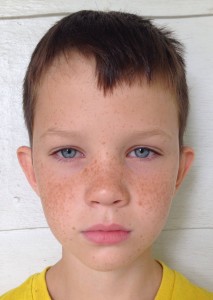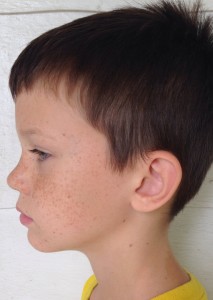Functional Orthodontics Versus Traditional Orthodontics

Functional Orthodontics
This is a very interesting branch of orthodontics that most people have not heard about. Functional orthodontics consists of not only straightening a person’s teeth but repositioning the upper and lower jaws to create a better profile.
Many patients seek orthodontic treatment because of crowding and crooked teeth. Oftentimes, the teeth are crowded because the mouth is narrow. Those practitioners that believe that the mouth is narrow due to genetics and believe that the shape of the mouth cannot be changed will often extract 4 teeth, usually four premolars to make room for the crowded teeth. This is called ‘’traditional 4 bicuspid extraction techniques.’’
Those practitioners that believe environmental factors caused the mouth to become narrow will use expansion appliances to widen the mouth. When the mouth is widened, space is gained and the teeth then can be aligned. This is called “non-extraction , functional appliance technique.”
If there is a weak chin or misalignment of either jaw the bite will be thrown off. This could lead to producing migraines, neck and shoulder pain, dizziness, sleep apnea, hearing problems, TMJ, upper airway obstruction and poor facial profiles.
Functional orthodontics approaches straightening teeth in a different way. Instead of pulling crowded teeth, the jaw is expanded to make room for them. When appliances are worn to widen the jaw, both upper and lower, it makes for a more balanced profile. It also helps to expand the sinus and to correct sleep apnea or breathing problems.


With the non-extraction technique, which uses expansion appliances to widen the dental arch in patients, you can achieve great results. However, these appliances are non removable and must be kept in place to be effective for a specified time. Some patients have issues with this. But the results are well worth the effort involved.
By correctly harmonizing the facial-skeletal structures through Functional Orthodontic treatment, medical problems such as temporomandibular disorders, migraine headaches, neck-shoulder-back pains, dizziness, ringing in the ears, hearing problems, upper airway obstructions/mouth breathing, sleep disorders/sleep apnea, and other problems may be alleviated.
Traditional Orthodontics
This is called ‘’traditional 4 bicuspid extraction technique’’
Although room is made, it can lead to a narrow and flattened facial profile that cannot be changed later.

With myriad problems resulting from extraction treatment, however, one must question whether this method is an easy way out for the practitioner rather than an optimal solution for the patient.
In the short term extraction is hard on the body, with trauma to the surrounding tissue, use of anesthesia, and potential for complications such as bleeding and dry sockets. Beyond these immediate issues, extracting teeth and closing the gaps narrows the dental arch, allowing less room for the tongue and potentially reducing the volume of the posterior airway.
The approach can lead to long-term conditions such as sleep apnea, and even damage the facial structure. A narrow arch provides less bony support for the face, sometimes leading to a dished- in appearance from the side as well as a narrower facial structure and smile.
The difference between extraction and non-extraction treatment is exemplified by a paper published by Dr. H.L. Eirew in the British Dental Journal in 1976. Two identical twin girls had presented with identical cases of crowded teeth.

One received extraction treatment (E), while the other had her palate expanded (F). The resulting differences are nothing short of profound.
For many years, orthodontists have practiced with the belief that we have evolved to have smaller jaws that are unable to accommodate all 32 teeth. Looking at the history of malocclusion, however, it becomes apparent that the rise of crooked teeth is closely paralleled with the rapid rise of civilization – something that has only taken off in the last four hundred years; a relative blink of an eye with the process of creation taking millions of years.
This amount of time is simply too short for our genes to have changed significantly. As such, it seems that crooked teeth are not a result of genetically smaller jaws but rather a developmental effect of our modern lifestyles.
Once we accept that narrow jaws and malocclusion are environmental rather than genetic, the focus of orthodontic treatment necessarily changes from the easy route of extracting teeth to the optimal solution of expanding the jaw to accommodate the teeth.
Your smile is one of the first things people notice about you. Dental braces, in general, are made to help a patient whether an adult or child to have straighter teeth. Dentists have found that if the appliance is removable children will do just that and the results will be compromised.

Orthodontic Treatment
Some practitioners do not feel that orthodontic treatment can affect facial appearance and the health of the temporomandibular joints, while others feel otherwise.
Over time there has been new information about ways to treat dental abnormalities. There are obviously different approaches and you will need to assess what is right for you or your child. Know your options before you take that first step.
The growth of a child’s face may require you to decide due to the over crowding of their teeth.
No one wants their child to face surgery. This functional orthodontics option is a way to handle all of the issues of overcrowding without blood.
Things to Look For When Deciding
* Does your child have a narrow face compared to their friends? Skeletal genetics such as big bones or small are not the issue. Looking at the child’s face does it seem pointy or recessed near the chin?


Narrow Healthy
* When turned sideways can you lay a pencil on the forehead and is it aligned with the chin. No concave appearance you are looking for a well-formed profile.


Concave profile Healthy Profile
* Is your dentist open to using the functional orthodontics in his dental practice? The education of patients is one of the most important jobs of a dental office.
Conclusion
One may wonder why all orthodontic practitioners do not treat all patients with Functional Orthodontic treatments. It is because currently there are two schools of thoughts.
One school teaches that abnormal facial and dental features are caused by genetics. These practitioners feel that the facial skeletal structures are genetically determined and therefore cannot be changed.
The other school teaches that abnormal facial and dental features are caused by environmental factors.
Since environmental factors, and not genetics, caused the abnormal facial and dental growth, then the facial-skeletal structures can be changed to a more ideal and harmonious shape and position.

There are different approaches to the same problem. So it is up to the parent to choose. But there is something to keep in mind when deciding. Traditional Orthodontics gives you straight teeth.
Functional orthodontics gives you a beautiful face and straight teeth. The choice is yours.
HH Wellness supports the Functional Orthodontic model and is part of a team to accomplish proper facial appearance and growth
Click Here to take a FREE comprehensive screening for your child or for an adult screening
My Orofacial Myofunctional Therapy programs include:
1. Habit elimination therapy
2. Exercises to improve nasal breathing and oral facial functions
3. Teaching and promoting proper chewing, breathing, and swallowing
4. Re-patterning head and neck posture problems
5. Generalization and habituation of the new muscle patterns.
6. Emotional balancing
Parental involvement is very important to a child's success, and key to that success is a supportive environment that provides consistent encouragement and motivation necessary for positive and permanent change.
Find a dentist https://www.iaortho.org/find-a-dentist/

50% Complete
Two Step
Lorem ipsum dolor sit amet, consectetur adipiscing elit, sed do eiusmod tempor incididunt ut labore et dolore magna aliqua.
